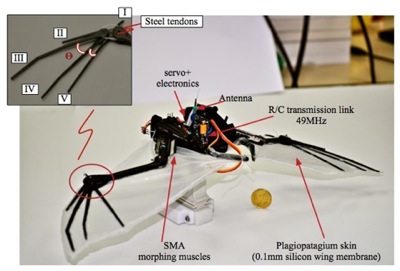This article is more than 1 year old
Bot imitates bat for better flight
Flying fox the model for ‘BaTboT’
It may be despised as the vector of a really nasty virus*, but like all bats, Australia’s Grey-headed Flying Fox is an aerobatic (sorry) marvel – and it’s provided part of the model for researchers trying to mimic bat flight using a combination of articulated wings and smart materials.
The Madrid Polytechnic researchers, working with America’s Brown University, say they want to create a flyer that borrows one of the tricks that makes bats so agile: the ability to change the shape of their wing during flapping.
That’s not easy to achieve. As the researchers describe in this paper, the bat’s wing has flexible bones, independently controllable joints, and the wing membrane’s tension surface is controlled by its own tiny muscles.

How to build a bat: Madrid Poly's BaTboT
To mimic this, the artificial bat wing needs a skeleton that can be actuated without getting too heavy, and a similarly-lightweight wing. BaTboT’s wing is a membrane of silicon 0.1 mm thick, with shape-memory alloys (SMAs) providing muscle action to both the wings and the steel tendons in the wing.
The current iteration of BaTboT has two aims: creating an architecture for SMA-driven flight, and “validating through aerodynamics experiments that our morphing-wings approach contributes in increasing lift force during the wing’s downstroke and reducing drag during upstroke”.
The onboard electronics includes an RF receiver, an Arduino-based controller, and MOSFETs to drive the SMA actuators. ®
